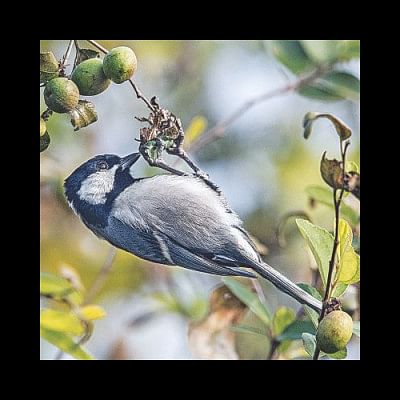The Iora and the Tit

It is a very cold morning. I am back in Purbachol after several weeks. Walking across my favourite field, I approach a thicket of trees and bushes. The trees include boroi (the local variety with sour fruits), nachna, sajna and raintree as well as several palms. Filling the space between them are bushes of akond, lantana, other nameless weeds and tall grass. A vegetable farmer's macha – the bamboo platform for growing creepers, sheem in this case – sits in the middle of this hodgepodge of flora. This area has rewarded me well in the past: Siberian rubythroat, Brahminy starling and Burmese shrike are among the rare gems I photographed here. In fact, I have never returned empty-handed. Today I pay particular attention to underside of the dried bushes where I hope to see another rubythroat.
But, as often happens in birding, I get distracted.
Distraction arrives in the form of a flock of olive-backed pipits, nondescript gray-green birds that are making their way from one tree to another, like a wave washing over them. I am thrilled to be photographing them for the first time, and a special bonus appears in the form of dumpy round tailless chick that has just learned to fly.
Soon the pipits are gone, but I stay frozen at my spot, watching a boroi tree to my right where the last one had perched. Presently I catch a flicker of movement behind the dense patchwork of leaves. I see parts of the bird: a cinereous tit. It flits around in the back of the tree. Moments later on a branch to the left, I see an iora.
This is a photographic eat-all-you-want buffet. Should I aim my camera at the iora or the tit?
The iora is greenish-yellow with gray and white stripes running along its wings. It is a tropical bird, found in the subcontinent and southeast Asia. The tit, on the other hand, is monochromatic, with bold black lines and patches covering parts of its white body. It is a global bird with a wide range.
They both hunt for insects among the leaves of the boroi. But what a difference in style and movement! The iora – like a soft furry ball – moves in fluid, acrobatic motion. It flexes into various contortions while looking for prey, blending into its native vegetation. The tit, on the other hand, is muscular, strong, with angular movements. Its body appears less flexible than the iora's. To look at the underside of an insect nest in the form of rolled leaves, it hovers, then hangs upside down. The iora could accomplish this by perching nearby, reaching out its torso and twisting its neck. They stay out of each other's way and clean out the worms and insects before moving on eastward to the next tree.
The boroi tree and bushes fall silent after the birds are gone – birds that are common to birders and no cause for great excitement. Yet, on this cold morning they had arrived like a burst of warm sunshine and I am grateful for having witnessed a few intimate moments of their lives.
www.facebook.com/ikabirphotographs or follow ihtishamkabir on Instagram

 For all latest news, follow The Daily Star's Google News channel.
For all latest news, follow The Daily Star's Google News channel. 




Comments